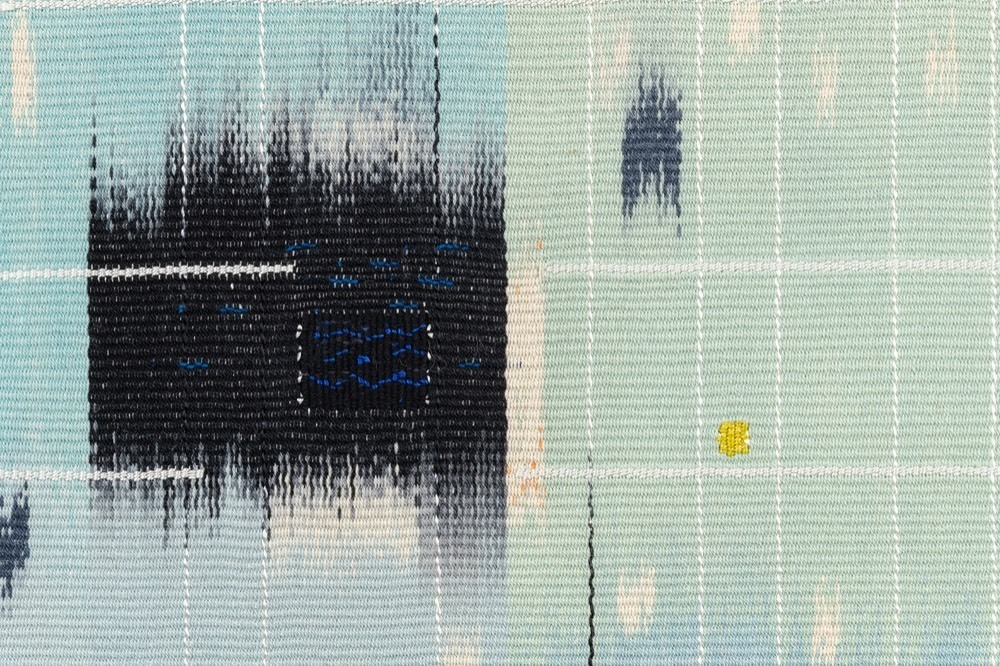With a career spanning more than 50 years, Carin Wessel has distinguished herself as one of Norway’s most illustrious weavers. She is known for her colourful tapestries made with the ikat technique, and for her many works of public art. In the exhibition at SOFT, she presents works from 1989 to 2016.
Wessel has developed a unique expression using the ikat dyeing technique in combination with flat-loom weaving. The technique has roots dating back to the 600s in Indonesia, but it has spread to many parts of the world, also to Scandinavia. Before the dyeing process, parts of the yarn are wrapped tightly with a dye-resistant material to keep those parts from being penetrated by colour. The dyeing can be done in several stages and in different parts of the yarn in order to achieve gradual colour transitions. The method gives Wessel opportunities to create intensity and strength in her colours and patterns. She uses the glossy wool of the spælsau (a Northern European breed of short-tailed sheep), sometimes in combination with other fibres such as silk and nylon. The ikat technique and glossy yarn create strong effects of light in her tapestries.
Colour compositions have a central place in Wessel’s abstract motifs. She herself says that walking trips through forests and mountains and by the sea give her the colour impressions that she captures with her eyes and camera lens. These in turn give her ideas and impetus for new works. Several tapestries have titles alluding to experiences of nature, examples being ‘Uvær i sikte’ (‘Bad Weather in Sight’), ‘Morgensol’ (‘Morning Sun’) and ‘Snøen smelter’ (‘The Snow Melts’).
In the forthcoming publication, Nina Schjønsby writes that ‘Suggestive expressions, open to interpretation, characterise Wessel’s art; titles and moods can put us on a track, give a direction, but Wessel leaves room for us as viewers’. In the work that shares the same title as the exhibition, Brev til en ukjent / Letter to Someone Unknown (1989), the sewed-on patches can draw associations to marginal or post-it notes in a larger narrative. Given that Wessel calls the work a ‘letter’, she emphasises strands of fibre as carriers of meaning and the textile as a visual language.
Carin Wessel (born 1944) lives and works in Oslo. Her studio is at the art centre Frysja kunstnersenter. She studied at the National College of Art and Design in Oslo (1964–68) and at Nycklevikskolan in Stockholm, where she studied architecture (1971–72). Wessel has exhibited at (a selection) Galleri F15 in Moss, Henie Onstad Kunstsenter at Høvikodden, Telemark fylkesgalleri in Notodden, Kunsthall Stavanger and Kunstnerforbundet in Oslo. She has also exhibited in the USA, Romania and Belgium.
Her public art includes ‘Ad Astra’ at Oslo’s Gardermoen Airport and two works for the foyer of the Government-Quarter building ‘R4’, plus works for Lindesnes Lighthouse Museum, the engineering college Kongsberg ingeniørhøyskole, the national telecommunications company Teledirektoratet, SAS Hotel Oslo and Vestfold Bank, among others. In addition to her artistic practice, Wessel has been a public art consultant, for instance for Ullevål Hospital.
carinwessel.com
The exhibition is supported by Arts Council Norway, Oslo Municipality and the Bergesen Foundation




